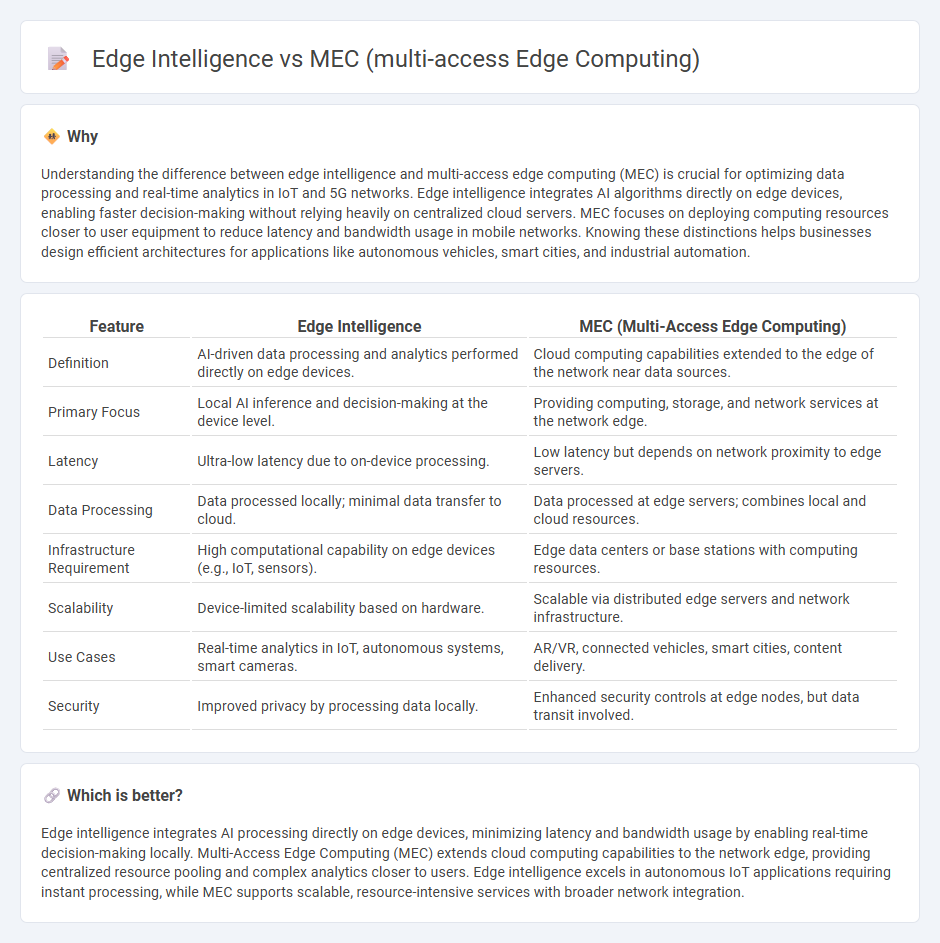
Edge intelligence integrates artificial intelligence algorithms directly into edge devices, enabling real-time data processing and decision-making without relying on centralized cloud servers. Multi-access Edge Computing (MEC) extends cloud capabilities by bringing computing power closer to end-users through localized data centers, reducing latency and enhancing service quality. Discover how these cutting-edge technologies transform network infrastructure and drive the future of connected applications.
Why it is important
Understanding the difference between edge intelligence and multi-access edge computing (MEC) is crucial for optimizing data processing and real-time analytics in IoT and 5G networks. Edge intelligence integrates AI algorithms directly on edge devices, enabling faster decision-making without relying heavily on centralized cloud servers. MEC focuses on deploying computing resources closer to user equipment to reduce latency and bandwidth usage in mobile networks. Knowing these distinctions helps businesses design efficient architectures for applications like autonomous vehicles, smart cities, and industrial automation.
Comparison Table
| Feature | Edge Intelligence | MEC (Multi-Access Edge Computing) |
|---|---|---|
| Definition | AI-driven data processing and analytics performed directly on edge devices. | Cloud computing capabilities extended to the edge of the network near data sources. |
| Primary Focus | Local AI inference and decision-making at the device level. | Providing computing, storage, and network services at the network edge. |
| Latency | Ultra-low latency due to on-device processing. | Low latency but depends on network proximity to edge servers. |
| Data Processing | Data processed locally; minimal data transfer to cloud. | Data processed at edge servers; combines local and cloud resources. |
| Infrastructure Requirement | High computational capability on edge devices (e.g., IoT, sensors). | Edge data centers or base stations with computing resources. |
| Scalability | Device-limited scalability based on hardware. | Scalable via distributed edge servers and network infrastructure. |
| Use Cases | Real-time analytics in IoT, autonomous systems, smart cameras. | AR/VR, connected vehicles, smart cities, content delivery. |
| Security | Improved privacy by processing data locally. | Enhanced security controls at edge nodes, but data transit involved. |
Which is better?
Edge intelligence integrates AI processing directly on edge devices, minimizing latency and bandwidth usage by enabling real-time decision-making locally. Multi-Access Edge Computing (MEC) extends cloud computing capabilities to the network edge, providing centralized resource pooling and complex analytics closer to users. Edge intelligence excels in autonomous IoT applications requiring instant processing, while MEC supports scalable, resource-intensive services with broader network integration.
Connection
Edge intelligence leverages Multi-Access Edge Computing (MEC) to process data closer to the source, reducing latency and enhancing real-time analytics capabilities. MEC provides the infrastructure for deploying AI models at the network edge, enabling faster decision-making and efficient resource utilization. This synergy accelerates applications in IoT, autonomous vehicles, and smart cities by combining localized data processing with intelligent insights.
Key Terms
Latency
Multi-access edge computing (MEC) reduces latency by bringing cloud computing capabilities closer to the network edge, enabling real-time data processing and low-latency applications such as autonomous driving and augmented reality. Edge intelligence integrates AI and machine learning at the edge to optimize latency further by enabling predictive analytics and local decision-making without relying on centralized cloud servers. Explore more about how MEC and edge intelligence revolutionize latency-sensitive applications and network performance.
On-device AI
Multi-access edge computing (MEC) enhances real-time data processing by deploying cloud capabilities closer to the network edge, minimizing latency and optimizing bandwidth. Edge intelligence leverages on-device AI to perform autonomous analytics and decision-making directly on user devices without relying heavily on centralized servers. Discover how integrating MEC and edge intelligence transforms industries through ultra-responsive and efficient AI applications.
Distributed architecture
Multi-access edge computing (MEC) enables distributed architecture by bringing cloud computing resources closer to end devices, reducing latency and enhancing real-time data processing at the network edge. Edge intelligence integrates artificial intelligence algorithms directly into MEC systems, allowing autonomous decision-making and advanced analytics at distributed nodes without relying on centralized cloud infrastructure. Explore the differences in MEC and edge intelligence distributed architectures to optimize your edge computing strategy.
Source and External Links
What is multi-access edge computing? | HPE Juniper Networking US - Multi-Access Edge Computing (MEC) moves computing and services from centralized clouds to the network edge, reducing latency and enabling real-time performance for high-bandwidth applications by processing data closer to users.
What is Multi Access Edge Computing | Glossary | HPE - MEC is a distributed computing architecture that places computational resources and services near the network edge--often within the radio access network--to minimize latency, speed up data processing, and support real-time applications like IoT, AR/VR, and autonomous vehicles.
Multi-access edge computing - Wikipedia - MEC, defined by ETSI, enables cloud computing and IT services at the edge of cellular and other networks, allowing applications to run closer to end-users for reduced network congestion, better performance, and flexible deployment of new services by operators and third parties.
 dowidth.com
dowidth.com